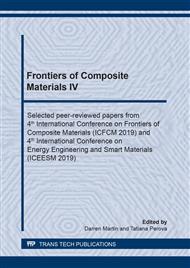[1]
M. Alberto: Fiber Reinforced Polymers - The Technology Applied for Concrete Repair, InTech, (2013).
Google Scholar
[2]
T. Sathishkumar, S. Satheeshkumar and J. Naveen: J. Reinf. Plast. Compos., vol. 33, no. 13, p.1258–1275, Jul. (2014).
Google Scholar
[3]
M. Frigione and M. Lettieri: Polymers (Basel)., vol. 10, no. 3, p.247, Feb. (2018).
Google Scholar
[4]
D. Pico, C. Wilms, G. Seide, T. Gries, R. Kleinholz and H. Tiesler: Ullmann's Encyclopedia of Industrial Chemistry, Weinheim, Germany: Wiley-VCH Verlag GmbH & Co. KGaA, (2012).
DOI: 10.1002/14356007.o11_o01.pub2
Google Scholar
[5]
D. Chung: Kirk-Othmer Encyclopedia of Chemical Technology, Hoboken, NJ, USA: John Wiley & Sons, Inc., 2015, p.1–39.
DOI: 10.1002/0471238961
Google Scholar
[6]
S. S. Heckadka, S. Y. Nayak, K. Narang and K. Vardhan Pant: J. Mater., vol. 2015, p.1–7, Sep. (2015).
Google Scholar
[7]
P. Hiremath, M. Shettar, M. C. Gowrishankar, V. R. Chauhan and R. Nikhil: I. J. Tech. vol. 8, no. 3, (2017).
Google Scholar
[8]
R. M. Wang, S. R. Zheng and Y. P. Zheng: Polymer Matrix Composites and Technology, Elsevier, (2011).
Google Scholar
[9]
M. Shettar, U. Achutha Kini, S. Sharma and P. Hiremath: Mater. Today Proc, vol. 4, no. 10, p.11158–11162, (2017).
DOI: 10.1016/j.matpr.2017.08.081
Google Scholar
[10]
M. Shettar and P. Hiremath: I. J. of App. Eng. Res. , vol. 10, no. 19, (2015).
Google Scholar
[11]
M. D. Kiran, H. K. Govindaraju, T. Jayaraju and N. Kumar: Mater. Today Proc., vol. 5, no. 10, p.22421–22424, (2018).
DOI: 10.1016/j.matpr.2018.06.611
Google Scholar
[12]
K. P. Aveen, V. Bhajantri, R. D'Souza, N. V. Londe and S. Jambagi: AIP Conf. Proc. 2019, p.020044.
Google Scholar
[13]
V. Singh, P. Kumar and V. K. Srivastava: Mater. Res. Express, vol. 5, no. 6, p.065323, Jun. (2018).
Google Scholar
[14]
U. Rai and R. Singh: Mater. Lett., vol. 58, no. 1–2, p.235–240, Jan. (2004).
Google Scholar
[15]
D. M. Nuruzzaman, A. K. M. A. Iqbal, A. N. Oumer, N. M. Ismail and S. Basri: IOP Conf. Ser. Mater. Sci. Eng., vol. 114, p.012118, Feb. (2016).
DOI: 10.1088/1757-899x/114/1/012118
Google Scholar
[16]
S. K. Zade, Suresh Babu V and Sai Srinadh K.V: W. J. of Eng. vol. 15, no. 2, p.312–320, Apr. (2018).
Google Scholar
[17]
R. Bhat, N. Mohan, S. Sharma, A. Pratap, A. P. Keni, and D. Sodani: J. Mater. Res. Tech. vol 8, no. 4, pp.3653-3661 Jun. (2019).
Google Scholar


